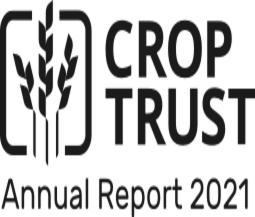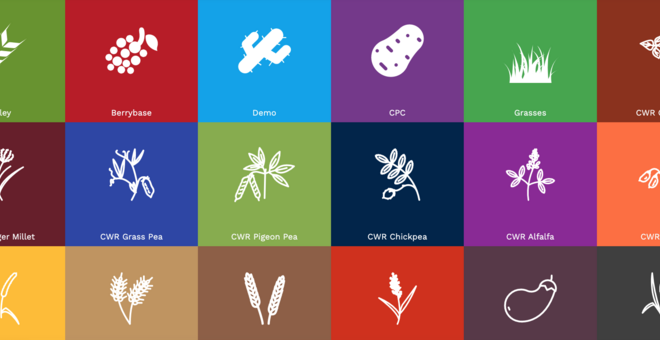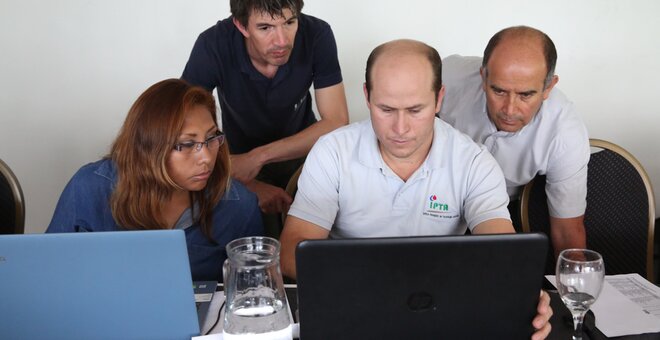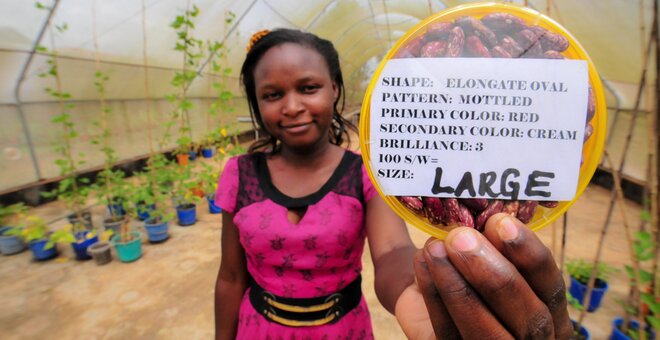No data? No conservation.
Data is the lifeblood of crop diversity conservation and use.
Without it, genebanks would not be able to manage their collections effectively—whether of rice or banana. In turn, plant breeders and researchers need information on what diversity is held where, and what its characteristics are, so they can make informed choices about what to use—whether in their rice improvement program or banana physiology study. Basically, without the data that accompanies seeds or test tubes onto their shelves, genebanks might as well be prisons of diversity rather than tools for improving food security.
This is why Genesys, GRIN-Global Community Edition (GGCE) and, most importantly, their global network of partners who ensure that this data is accessible and up-to-date, are so important.
At a glance
The Crop Trust supports the management and availability of information on plant genetic resources for food and agriculture at the global scale through Genesys. GRIN-Global Community Edition (GGCE), on the other hand, is used internally in genebanks as a solution to data-driven management of collections.
As the development of both Genesys and GGCE is supported by the Crop Trust Endowment Fund, we take special care to ensure seamless data flows between GGCE in individual genebanks and the global database, Genesys. Both, in turn, contribute to the International Treaty on Plant Genetic Resources for Food and Agriculture’s Global Information System (GLIS).
- HIGHLIGHTS FROM 2022: Passport data on more than 3 million genebank accessions were refreshed and confirmed in Genesys in 2022, bringing 94 percent of accessions up to date; more than 50,000 new accessions were registered; one new data provider joined Genesys; a new-look Genesys portal was launched in June and several new functionalities were developed; and nine GGCE updates were released.

It was an exciting year. We finally established a Genebank Information Systems team at the Crop Trust that covers not just Genesys, but also GRIN-Global Community Edition. This combination has the potential to make a big difference in data management and availability in genebanks and, by extension, also in Genesys.
Updates, more data and a new look for Genesys
Genesys is an online portal that allows users to explore the world’s crop diversity conserved in genebanks. At the end of 2022, it housed information on nearly 4.3 million accessions, with data from 41 data providers that range from large networks of genebanks, such as the European Cooperative Programme for Plant Genetic Resources (ECPGR) and the CGIAR genebanks, through to individual national genebanks. One new data provider—the Ethiopian Biodiversity Institute—joined the platform in 2022.
Genesys serves two distinct but connected groups. Genebank staff use the platform to publish data on the diversity they maintain. And then there are plant breeders and researchers, who use Genesys to explore that diversity and identify the material that best meets their needs.
Passport data—information such as the name of the species and landrace, where and when it was originally collected, and where it is being kept—on a total of more than 3 million accessions was refreshed or confirmed in 2022 by the following partners: the CGIAR genebanks (AfricaRice, the Alliance of Bioversity International and CIAT, ICARDA, ICRISAT, IITA, ILRI, CIP, IRRI, CIMMYT, World Agroforestry); the Agricultural Plant Genetic Resources Conservation and Research Centre, Sudan; the Australian Pastures Genebank and Australian Grains Genebank; the Centre for Pacific Crops and Trees at SPC, Fiji; EMBRAPA, Brazil; ECPGR via EURISCO; the Margot Forde Germplasm Centre, New Zealand; the Millennium Seed Bank, Kew, UK; the National Centre for Genetic Resources and Biotechnology, Nigeria; the National Plant Genetic Resources Centre, Zambia; the Plant Genetic Resources Research Institute, Ghana; the Wheat Genetics Resource Center, Kansas State University, USA; and the World Vegetable Center.
This brought 71 percent of the accessions in Genesys fully up to date. Approaching the remaining data providers for updates will be a priority in 2023.
In June 2022, Genesys received a new look and feel, with changes to the navigation menu and a new “table view” in the accession browser that helps users quickly find accessions that have the characteristics they are looking for.
Promoting the use of ‘subsets of accessions’
Genebank subsets are groups of accessions with a particular trait or traits that users might be interested in, such as drought or salinity tolerance, and a user-friendly way to view information on Genesys. For example, subsets offer genebank staff different ways to slice and dice their collection and make it more interesting to different types of users.
To promote the use of subsets, the Crop Trust hosted a webinar on the topic in May 2022. The event attracted 70 participants from 35 organizations.
Thirty-five subsets were uploaded to Genesys in 2022, by AfricaRice, CIP, ICRISAT, the World Vegetable Center, the Australian Pastures Genebank, the Wheat Genetics and Genomics Resources Center, and the Alliance of Bioversity International and CIAT. This brings the total number of subsets hosted by Genesys to 283.
A growing number of users
The number of registered users of Genesys increased from 2,288 at the end of 2021 to 2,768 at the end of 2022. These are mainly plant breeders and researchers who are interested in working with the wide range of diversity conserved in genebanks—an exclusive community that plays a key role in broadening the genetic base of the world’s food crops by making use of the diverse material available in genebanks in order to enhance the resilience of agriculture to challenges such as climate change.
Nine GGCE updates released
GRIN-Global Community Edition (GGCE) is an information system that is being developed by the Crop Trust with and for genebanks. It cuts out the intermediary, bringing data capture and use to the people who actually generate and depend on the data. While it was created in English, it is available in Arabic, Chinese, French and Spanish, thanks to the contributions of diverse GGCE users.
GGCE is designed for genebank technicians. It provides intuitive user interfaces to support data capture and use in routine genebank operations. GGCE is strongly focused on the barcoding of samples, which allows genebank staff to quickly and reliably pull up the correct information on any packet of seed or test tube in their genebank.
Labelling of material, including a unique barcode (QR, datamatrix, or other) assigned to each, is “baked” into the software and helps establish a direct connection between the material and the data held in GGCE.
In addition to barcode scanners and label printers, GGCE also connects with other electronic gear. It boasts features such as the ability to capture seed weight directly from an electronic scale—thus removing the need for manual entry and eliminating the risk of error—and it allows for direct capture of images of samples using a mobile phone.
Did we already say it works on a mobile phone? Well, it does.
Improvements to the GGCE software are developed in consultation with genebanks and are made available as new versions of GGCE. Nine such versions were released in 2022, building on the work done in 2021.
One of these improvements enhanced the links with the DOI Registration Service of the International Treaty on Plant Genetic Resources for Food and Agriculture. DOIs—digital object identifiers—"attach” a unique identifier to each accession. This improves users’ access to data by describing the material and enabling traceability as samples are exchanged between genebanks and breeders, and are used in publications. GGCE enables data managers and collection curators to obtain DOIs with one click, without the need for massaging data into the required format.
Similarly, it allows genebanks to send updated passport data to Genesys on demand and to retrieve information on material requested by Genesys users for processing. The updated software makes it easy for genebanks to respond to requests for seed samples, including assisting in the selection of appropriate material, tracking outgoing samples, printing labels for packets and generating the paperwork necessary when seed samples are sent to users, such as packing lists and material transfer agreements.
Two major genebanks using GGCE and more testing it
WorldVeg and Future Seeds, the futuristic genebank of the Alliance of Bioversity International and CIAT in Colombia, are using GGCE as the primary system for managing their collections. Eighteen more genebanks are testing and evaluating the system with support from the Crop Trust, whose staff presented it to a further 60 genebanks in 2022. We are expecting to increase interest further in 2023.
Related news and resources
Germinate: Crop Data at Your Fingertips
Until all too recently, sharing information on genetic resources was a hugely inefficient process that made collaboration, at times, impossible.
The solution has been to create online repositories that offer easy-to-share data...
9 Jun 2021
9 Jun 2021
Enhancing the Genesys Portal
Information is liberating
Data and information systems make our lives easier, in our personal capacity and in our workspace, allowing us to access the information we need with ease and efficiency. In the world of plant genetic...
22 Jun 2017
22 Jun 2017
GRIN-Global Community Edition: A Collective Step Forward for Genebank Data Managers
All genebanks need sound data management to keep track of the inventories of seeds in their cold rooms and fields, and of all their interlinked processes.
For a long time, the CGIAR genebanks have taken their own unique...
7 Jan 2022
7 Jan 2022
GRIN-Global: A Data Management Tool for All Genebanks
Genebanks safeguard and make available the genetic diversity of our food crops. This is a critically important endeavor, but protecting and sharing plant materials – seeds, tissues in test tubes etc. – alone is not enough. Beyond...
17 Aug 2016
17 Aug 2016
More Than Just Passport Data Now Available on Genesys
Michael Major, Crop Trust
Banner photo: Georgina Smith/CIAT
Genesys, the global online portal to information about plant genetic resources for food and agriculture (PGRFA) in genebanks, has been significantly enhanced with the...
13 Dec 2018
13 Dec 2018






